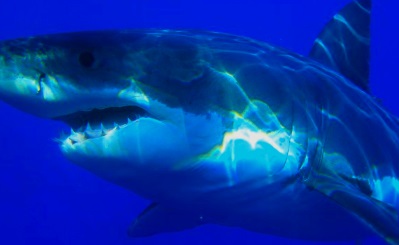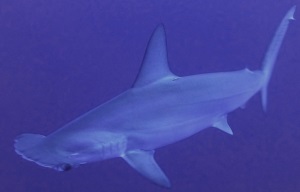Many holidaymakers are afraid when they go swimming in the sea in Greece. Is this fear justified? Are there dangerous sharks in Greece? How many shark attacks are there each year? This article aims to answer these questions.
There are around 50 species of sharks in the Mediterranean. Around 10 to 15 of them are dangerous to humans. The other species are relatively harmless because they are small. Attacks on humans in the Mediterranean occur, for example, by the following three species of shark: bull sharks, tiger sharks and the famous great white shark. All three species are relatively rare in the sea around Greece (Aegean, Libyan Sea and Adriatic). Bull sharks and tiger sharks are mainly found in tropical oceans (such as the Atlantic, Pacific and Indian Oceans). However, every now and then they stray into the Mediterranean. This often happens in summer or autumn, when the water around Greece is warm enough for the sharks, which are over three metres long. The great white shark is a regular occurrence in the Mediterranean and now even in the North Sea, but is generally very rare. With a length of sometimes more than six metres, it is one of the largest sharks and fish in the world. Great white sharks are so rare around Greece that the sighting of one is sometimes worth a report in the newspaper or on television.
 The great white shark is considered the king of predatory fish
The great white shark is considered the king of predatory fish
However, there are other dangerous species. Here are a few examples: The blue shark can be dangerous to humans. It is quite common around Greece, but rarely comes to the coast. The shark, which is over 3 meters long, is more of a deep-sea fish. In contrast, the shortfin mako shark likes to live near the coast. Although this shark can grow to over 4 meters long and, as a true predator, feeds on larger fish, we are not aware of any attacks on humans in Greece. The same applies to its relative, the longfin mako, which is rarer around Greece, however. Various species of hammerhead sharks could also be a danger. For example, the smooth hammerhead shark (up to 4 meters long) lives on the coasts around Greece. These animals have already killed people elsewhere on earth. However, we are not aware of any cases in the eastern Mediterranean.
Tip: Hotels in Greece should be booked online. Prices are usually much cheaper and easier to compare. The best place to book is Booking.com.
 A hammerhead shark with the typical head shape
A hammerhead shark with the typical head shape
The porbeagle shark is also one of the potentially dangerous predatory fish in the Mediterranean. Attacks on people have already occurred in other parts of the Mediterranean. This 3-meter shark, for example, also lives in the North Sea, Baltic Sea and on the Atlantic coast of France, Belgium, the Netherlands and England.
Our Tip
Hotels in Greece are best booked via Booking.com: wide selection from guesthouses to resorts, real guest reviews, flexible (often free) cancellation, and fair prices.
The risk of being bitten by a shark in Greece while bathing or swimming in the sea is small, despite the long list of species. Of the 10 million people we estimate to be in the sea in Greece every year (Greeks and tourists), statistically far fewer than one is attacked by a shark.
There are several reasons for the low number of shark attacks. Firstly, the predatory fish have become quite rare. Overfishing in the eastern Mediterranean has also made the region less interesting for sharks. The sharks have also been hunted directly. Above all, however, most sharks only see humans as prey in exceptional cases. Attacks rarely occur, for example because sharks mistake a human for a prey fish. This can happen with a surfer, for example. A surfboard can look like a fish to a shark from below. But even such attacks are very rare in Greece and elsewhere.
To reassure you, here are a few figures: The University of Florida keeps a list of all known unprovoked shark attacks worldwide. It comes to the conclusion that there have only been around 50 shark attacks in Europe over the last 160 years or so. According to this study, the country with the most incidents in Europe is actually Greece, with 15 attacks. This means that, according to this list, statistically there has been a shark attack in Greece approximately every 10 years. Given the 10 million people we estimate to be in the sea in Greece every year, the chance of being attacked by a shark while swimming in the Mediterranean in Greece would be 1 in 100 million.
Or to put it another way: In Greece, a person dies from a shark about every 10 years. That’s 0.1 per year. On the other hand, more than 1,000 people die in traffic accidents in the country every year. This means that a death in road traffic would be 10,000 times more likely than death in the sea from a shark. If an average Greek drives 10,000 km in a car or motorcycle per year (assumption), it would be about as dangerous to be attacked by a shark as to drive a single kilometer. These are just example calculations that do not necessarily have to be exact.
Many more holidaymakers die in the sea, for example from overestimating their ability when swimming, currents or heart attacks, than from sharks. A significantly larger number of holidaymakers die when travelling to Greece by car, ferry or plane, fall in the mountains while hiking and much more. Even deaths from bee stings are probably more common than shark attacks. The risk of sharks is therefore low in Greece.
Incidentally, there are slightly more accidents caused by sharks elsewhere in the world. While only around 15 shark attacks have been recorded in Greece in over 100 years, in the USA, for example, there are over 1,000 and in Australia over 500. Fatal attacks occur again and again in Florida and Hawaii.
Actually, the number of attacks on people described above poses an even smaller risk to swimmers than described above. A large proportion of the 15 attacks in over 100 years in Greece were not on bathing holidaymakers, but on divers or fishermen, for example. Most beach holidaymakers don’t swim more than 100 metres out. Many of the dangerous shark species never or almost never come to the shore.
It should also be mentioned that the statistics from the University of Florida refer to “shark attacks” and not “deadly shark attacks”. By this we mean that, according to our understanding of the list, there have been 15 attacks on people by sharks in 160 years. Probably not all of them were fatal to humans. On the other hand, there could have been other shark attacks in Greece that are not recorded in the statistics. We cannot therefore provide exact figures. But one thing is certain: There are greater dangers on holiday in Greece than sharks in the sea.
➔ To book ferries within Greece, we recommend the reputable website Ferryscanner.com
Some examples of incidents involving sharks in Greece
2010: A fisherman from Chania (Crete) accidentally catches a great white shark. Nobody is injured. Nevertheless, the case makes headlines.
About 15 years ago: A sponge diver was bitten in the head by a shark. Location: Small Dodecanese island not far from Rhodes. The attack was not fatal.
1981: A diver from Australia was attacked by a shark east of mainland Greece (west of the Sporades island of Skiathos). He suffered moderate injuries.
1962: A shark attacked a fishing boat not far from Athens. The boat almost capsized. Nobody was injured.
1956: At that time, a great white shark also killed a swimmer off Corfu. However, he was traveling on his yacht and thus probably not in the immediate vicinity of the coast.
People catch sharks
People kill many more sharks than sharks kill people. In fact, many millions of sharks are caught and killed every year by fishermen around the world using nets, harpoons or other tools or weapons. From time to time, taverns in Greece also offer shark dishes, usually shark steak or something similar. Since sharks have become rare in the Mediterranean and they are important animals for the ecological balance in the sea, we do not order such dishes in restaurants.
The easiest way to see sharks in Greece is in an aquarium. In the Crete Aquarium near Hersonissos in Crete, for example, you can admire snout sharks that can be up to 3 meters long.
Do you have feedback, an addition, found an error or a comment? Send us an email to: mail@griechenland-insel.de